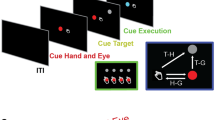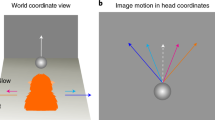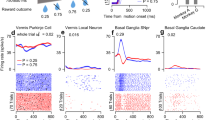Abstract
To plan an action, we must first select an object to act on and the body part (or parts) to use to accomplish our intention. To plan the motor task of reaching, we specify both the target to reach for and the arm to use. In the process of planning and preparing a motor task, information about the motor target and the arm to use must be integrated before a motor program can be formulated to generate the appropriate limb movement. One of the structures in the brain that is probably involved in integrating these two sets of information is the premotor area in the cerebral cortex of primates1,2,3,4,5. The lateral sector of the dorsal premotor cortex is known to receive both visual and somatosensory input6,7,8, and we show here that neurons in this area gather information about both the target and the body part, while subsequent activity specifies the planned action.
This is a preview of subscription content, access via your institution
Access options
Subscribe to this journal
Receive 51 print issues and online access
$199.00 per year
only $3.90 per issue
Buy this article
- Purchase on Springer Link
- Instant access to full article PDF
Prices may be subject to local taxes which are calculated during checkout




Similar content being viewed by others
References
Dum, R. P. & Strick, P. L. in Motor Control: Concepts and Issues (eds Humphrey, D. R. & Freund, H.-J.) 383– 397 (Wiley & Sons, New York, 1991).
Wise, S. P. The primate premotor cortex: past, present, and preparatory. Annu. Rev. Neurosci. 8, 1–19 ( 1985).
Passingham, R. E. The Frontal Lobes and Voluntary Action (Oxford Univ. Press, Oxford, 1993).
Kurata, K. Information processing for motor control in primate premotor cortex. Behav. Brain Res. 61, 135–142 (1994).
Rizzolatti, G., Luppino, G. & Matelli, M. The organization of the cortical motor system: new concepts. Electroencephalogr. Clin. Neurophysiol. 106, 283–296 (1998).
Caminiti, R., Ferraina, S. & Johnson, P. B. The sources of visual information to the primate frontal lobe: a novel role for the superior parietal lobule. Cereb. Cortex 6, 319–328 ( 1996).
Matelli, M., Govoni, P., Galletti, C., Kutz, D. F. & Luppino, G. Superior area 6 afferents from the superior parietal lobule in the macaque monkey. J. Comp. Neurol. 402, 327–352 (1998).
Fogassi, L. et al. Visual responses in the dorsal premotor area F2 of the macaque monkey. Exp. Brain Res. 128, 194– 199 (1999).
Kurata, K., Okano, K. & Tanji, J. Distribution of neurons related to a hindlimb as opposed to forelimb movement in the monkey premotor cortex. Exp. Brain Res. 60, 188–191 ( 1985).
Halsband, U. & Passingham, R. E. The role of premotor and parietal cortex in the direction of action. Brain Res. 240, 368–372 (1982).
Passingham, R. E. Premotor cortex and preparation for movement. Exp. Brain Res. 70, 590–596 (1988).
Petrides, M. Deficits in non-spatial conditional associative learning after periarcuate lesions in the monkey. Behav. Brain Res. 16, 95–101 (1985).
Kurata, K. & Wise, S. P. Premotor cortex of rhesus monkeys: set-related activity during two conditional motor tasks. Exp. Brain Res. 69, 327–343 ( 1988).
Mushiake, H., Inase, M. & Tanji, J. Neuronal activity in the primate premotor, supplementary, and precentral motor cortex during visually guided and internally determined sequential movements. J. Neurophysiol. 66, 705–718 (1991).
Boussaoud, D. & Wise, S. P. Primate frontal cortex: neuronal activity following attentional versus intentional cues. Exp. Brain Res. 95, 15–27 ( 1993).
di Pellegrino, G. & Wise, S. P. Visuospatial versus visuomotor activity in the premotor and prefrontal cortex of a primate. J. Neurosci. 13, 1227–1243 (1993).
Shen, L. & Alexander, G. E. Preferential representation of instructed target location versus limb trajectory in dorsal premotor area. J. Neurophysiol. 77, 1195– 1212 (1997).
Riehle, A. & Requin, J. Monkey primary motor and premotor cortex: single-cell activity related to prior information about direction and extent of an intended movement. J. Neurophysiol. 61, 534–549 (1989).
Kurata, K. Premotor cortex of monkeys: set- and movement-related activity reflecting amplitude and direction of wrist movements. J. Neurophysiol. 69, 187–200 (1993).
Wise, S. P., Boussaoud, D., Johnson, P. B. & Caminiti, R. Premotor and parietal cortex: corticocortical connectivity and combinatorial computations. Annu. Rev. Neurosci. 20, 25 –42 (1997).
Johnson, P. B., Ferraina, S., Bianchi, L. & Caminiti, R. Cortical networks for visual reaching: physiological and anatomical organization of frontal and parietal lobe arm regions. Cereb. Cortex 6, 102–119 (1996).
Hoshi, E., Shima, K. & Tanji, J. Neuronal activity in the primate prefrontal cortex in the process of motor selection based on two behavioral rules. J. Neurophysiol. 83, 2355–2373 (2000).
Tokuno, H., Hatanaka, N., Takada, M. & Nambu, A. B-mode and color Doppler ultrasound imaging for localization of microelectrode in monkey brain. Neurosci. Res. 36, 335– 338 (2000).
Acknowledgements
We thank M. Kurama, Y. Takahashi and S. Hoffman for technical assistance. This work was supported by the Japan Society for the Promotion of Science (E.H.), by the Ministry of Education, Science, and Culture of Japan, and by the Japan Science and Technology Corporation (J.T.).
Author information
Authors and Affiliations
Corresponding author
Supplementary information
41586_2000_BF35044075_MOESM1_ESM.pdf
Supplementary figure: Eye position traces during task performance. Additional information for the neuronal activity are shown in figure 4 in the main text. The vertical (V) and horizontal (H) eye positions are shown below each raster display. Scale bar, 1 second.
Rights and permissions
About this article
Cite this article
Hoshi, E., Tanji, J. Integration of target and body-part information in the premotor cortex when planning action. Nature 408, 466–470 (2000). https://doi.org/10.1038/35044075
Received:
Accepted:
Issue Date:
DOI: https://doi.org/10.1038/35044075
This article is cited by
-
Macaque dorsal premotor cortex exhibits decision-related activity only when specific stimulus–response associations are known
Nature Communications (2019)
-
Common and distinct neural correlates of dual-tasking and task-switching: a meta-analytic review and a neuro-cognitive processing model of human multitasking
Brain Structure and Function (2019)
-
Population coding of grasp and laterality-related information in the macaque fronto-parietal network
Scientific Reports (2018)
-
Clinical Characteristics and Lesions Responsible for Swallowing Hesitation After Acute Cerebral Infarction
Dysphagia (2016)
-
Autonomous Agents and Ethical Decision-Making
Cognitive Computation (2016)
Comments
By submitting a comment you agree to abide by our Terms and Community Guidelines. If you find something abusive or that does not comply with our terms or guidelines please flag it as inappropriate.



